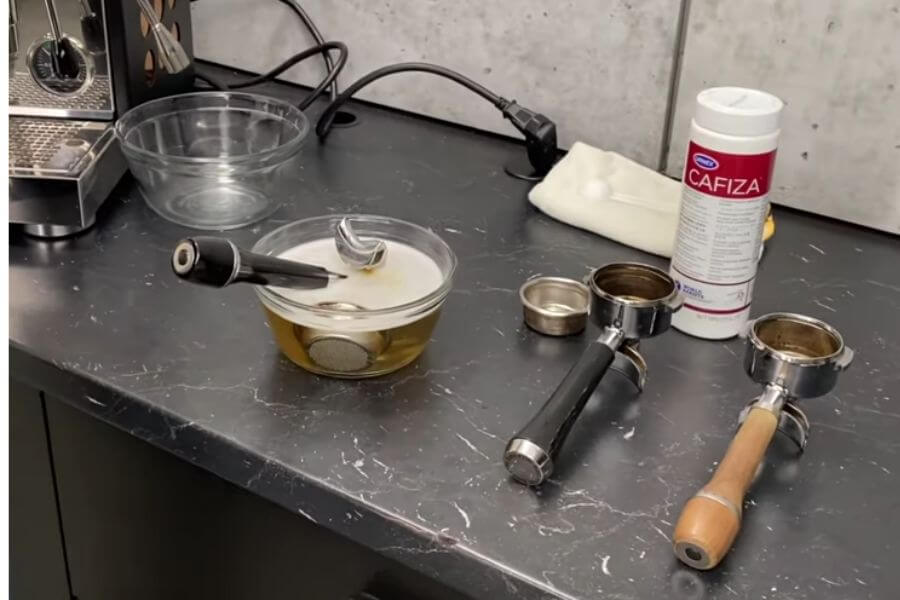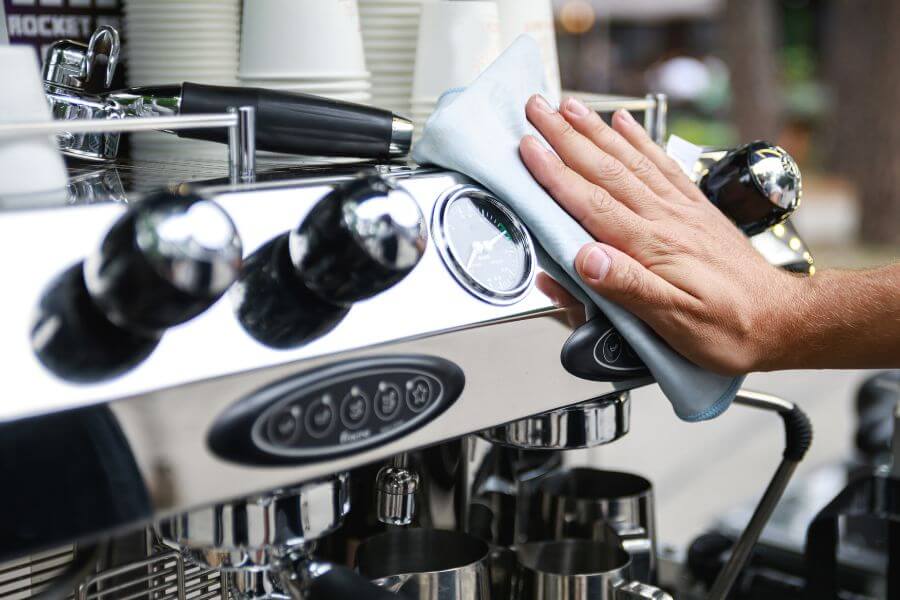Did your brand new home machine get dirty, and you need to learn how to clean an espresso machine?
In all my years of working as a barista, I mastered the process of keeping an espresso machine squeaky clean and fast.
That said, with the right tips, tricks, and tools, you’ll be able to cut down on maintenance time while still keeping up with high-quality standards just like me.
Here’s a detailed guide on how to clean your espresso machine and keep it in top condition:

Step-by-Step Guide to Cleaning an Espresso Machine
Step 1: Gather materials
Before starting the process of cleaning your espresso machine, it is important to gather all the necessary materials and equipment.
This includes a clean soft cloth and cleaning brush. Cleaning chemicals may also be necessary depending on the type of espresso machine you have.
Having everything organized and at arm’s length can greatly improve your efficiency in cleaning the machine and make for an overall smoother process.
Let’s start cleaning your espresso machine now.
Step 2: Empty and rinse the drip tray and water tank
When cleaning the espresso machine, one of the most important tasks is to empty and rinse out the drip tray and water tank.
This must be done every 24 hours or after 30 uses respectively, no matter what types of coffee you serve.
Replacing any used grounds in these compartments helps reduce residue build-up as well as eliminate unpleasant odours from forming in both your shop and machine.
It is also important to regularly change or descale the water in order to prevent any hard sediment from causing machine damage or hindering performance.
I will share more details later in this guide.
Step 3: Clean the portafilter and baskets
Keeping an espresso machine in perfect working order requires regular maintenance and thorough cleaning of the portafilter and group head basket.
Over time, a thin layer of oily substances known as coffee residues may build up in the portafilter, causing the espresso to have a burnt taste or no crema at all.
This issue can be easily resolved by scrubbing the portafilter with a brush or coarse towel or rinsing it with a chemical cleaner like Cafiza for heavier deposits. The same goes for the group head basket.
Let them sit in the dissolved cleaner (mixed with water) for about 5-10 minutes. Rinse them with fresh water and dry them with a clean cloth.

Step 4: Backflush the machine
To ensure a rich and strong espresso with every cup, backflushing your espresso machine should be done regularly.
Backflushing helps to clear out any debris or coffee oils from the inner workings of an espresso machine. It’s an essential practice to perform when it comes to maintaining your espresso machine.
To backflush, an espresso machine, start by turning the power off and unlocking the group head.
Take out the portafilter basket and replace it with a blind filter or backflush disk.
Place a small bowl to catch any excess water under the spouts of the machine, as some may leak out during backflushing.
Next, turn the power on and run a few short shots in order to prime your machine. This will create pressure within the group head and ensure that the water is forced through all of your internal parts.
After priming your machine, switch it off and add a teaspoon of espresso machine cleaning powder into each chamber of your portafilter basket or blind filter.

Put your portafilter or filter back into place, lock it in, switch on the pump and let it run for around 10 seconds to allow the cleaning powder to circulate throughout all of your internal parts.
Then turn off the pump and press down on both sides of your portafilter for about 5 seconds each time; this will help dislodge any build-up from within its walls.
Once finished, switch on the pump again for 10-15 seconds before shutting it off and unlocking your portafilter.
Finally, remove all traces of cleaning powder from both ends by running warm water through them for several seconds until no more suds are visible.
Doing so will help maximize the life of your machine and give you consistent results each time.
Though it may not seem necessary at first, regular backflushing is essential for both preventing clogs and preserving the flavour of your coffee.
Step 5: Clean the steam wand
Cleaning your espresso machine’s steam wand may seem like a finicky task, but it is important for both safety and good coffee.
If not properly cared for, the steam wand can develop residue of hard water or superfine particles which can introduce off-tastes into the beverage and be harmful to ingest.
It is best practice to clean the steam wand after every use. This will guarantee excellent-tasting cappuccinos and lattes every time without any unwanted flavours or risks!
To properly clean a steam wand, start by turning off the machine and unplugging it from the power source.
Next, take out the steam wand and hold it horizontally with one hand while wiping it with a damp cloth using your other hand.

Ensure that all of the milk residues are removed thoroughly. If you notice any stubborn bits of milk residue, use a soft bristled brush to scrub them off.
After that, rinse under hot water until all soap residue is gone. Finally, dry the wand with a clean towel and reattach it to the machine.
Step 6: Descale the machine (if necessary)
Descaling an espresso machine is a necessary maintenance task for ensuring the longevity of the appliance and for keeping it producing high-quality drinks.
The process involves removing any mineral deposits or scale that has built up over time from the water used in making the espresso.
Begin by removing all parts and components of your espresso machine, such as portafilters, baskets, screens and other accessories.
Finally, descale your machine by adding a commercial descaling agent into the tank according to the manufacturer’s instructions or an equal amount of citric acid dissolved in warm water (1/4 cup per quart).
Turn on the machine and allow it to run for several minutes before turning it off and allowing it to cool down overnight.
The next day, run more clean water through the system until no visible signs of scale remain in order to finish descaling your espresso machine.
Step 7: Wipe down the exterior of the machine
Wiping down the exterior of the machine is an important part of routine maintenance. Doing so prevents dirt and dust buildup, which can interfere with its performance.
If a machine isn’t wiped down regularly, these particles will accumulate, making it harder to clean the surface.

To get rid of accumulated dirt and dust, use a soft cloth dampened with water, or another cleaning solution if indicated.
Make sure to work in gentle, circular motions and be careful not to press too hard when wiping down the machine – doing so could cause scratches and signs of wear on its surface.
Taking care when wiping down the exterior means you’ll help keep your machine running in top shape for longer periods of time.
Step 8: Reassemble the machine
Once the espresso machine has been successfully cleaned, it is time to start assembling.
The portafilter should then be attached to the group head and secured with a twist. Next, the drip tray should be installed onto the base platform of the espresso machine.
Then, after ensuring all connections are secure, the water reservoir can be filled with cold filtered water up to its fill line before being placed into position on top of the espresso machine.
Finally, after powering on the machine, any settings such as grind size or dosing can be adjusted as necessary before you make espresso drinks.
Frequently Asked Questions
How often should I clean my espresso machine?
A general rule of thumb is to clean the machine after every use, which ensures that all leftover grinds, oils, and residue are removed. You should also perform a full deep clean once a month or each time you finish a bag of ground espresso beans.
Do I need to use a specific type of water to clean my espresso machine?
No, you do not need to use a specific type of water to clean your espresso machine. However, using filtered or distilled water is recommended.
How long does it take to clean an espresso machine?
Depending on the severity of the mess, it can take anywhere from several minutes up to an hour to thoroughly clean an espresso machine. If regular cleaning is done after each use, the time needed should be minimal.
How do I know when my espresso machine needs to be descaled?
Generally, you should descale your espresso machine every three months or whenever the machine notifies you – some machines have a built-in timer or light to alert you that a descaling process is required.
Can I use vinegar to descale my espresso machine?
Yes. You can use vinegar to clean and descale your machine. This option is inexpensive and has natural anti-bacterial properties.
Can I clean my espresso machine with baking soda?
Yes. Cleaning your espresso machine with baking soda is a great and safe way to get rid of the accumulation of coffee oils and minerals that build up over time.
Can I use regular dish soap to clean my espresso machine?
While it is possible to use regular dish soap to clean your machine, speciality espresso cleaners are generally considered the best route for optimum performance and results.
Can I clean my espresso machine with bleach?
Cleaning your espresso machine with bleach may seem like a quick and easy solution, but it is not recommended. Even if bleach is diluted, the chemical composition could still damage your machine over time.
Can I put my espresso machine parts in the dishwasher?
Depending on the type of machine and its components, simply rinsing with clean water may be sufficient to remove debris, oils, and other dirt residues. But yes, you can put them in the dishwasher too.
Cleaning Espresso Machine – Conclusion
All in all, taking care of your machine is crucial for creating great espresso drinks and for prolonging the life of the machine.
This means cleaning it regularly with chemicals like vinegar or special descaling solutions and physically scrubbing it to get rid of residue and prevent blockages.
As long as you follow these basic guidelines, keeping your espresso machine in excellent condition will be a very simple task!
Finally, remember to be patient with yourself and take the time to learn all of the ins and outs – the more knowledgeable you become in managing your machine, the better outcome it will bring you.
Hopefully, this post was informative and gave you some helpful tips on how to clean an espresso machine. Thanks for reading and happy brewing!
By the way, if you are an espresso beginner and you don’t own a machine yet, but you would like to, check out our best espresso machines for beginners.
What To Do Next?
I hope you enjoyed this post about the science of cleaning your espresso machine. I know have enjoyed preparing it for you.
Do you have any more questions about the topic? Let me know in the comments below!
Interested in learning more about espresso? My team and I invite you down to the rabbit hole. Check out our top espresso guides and keep on learning!
